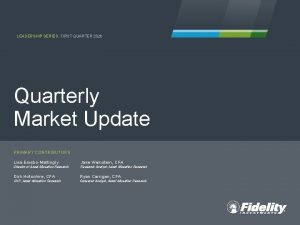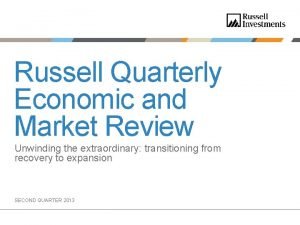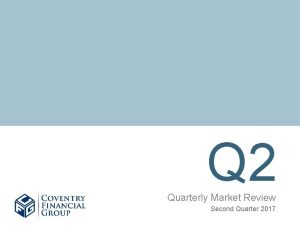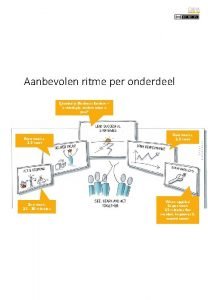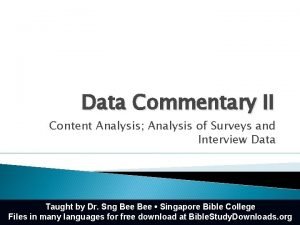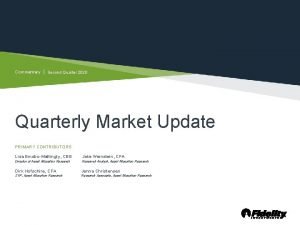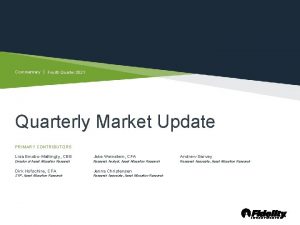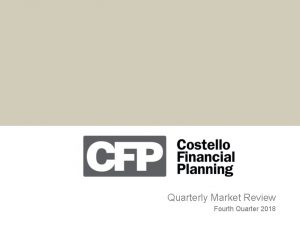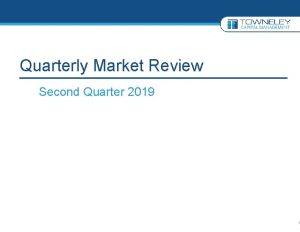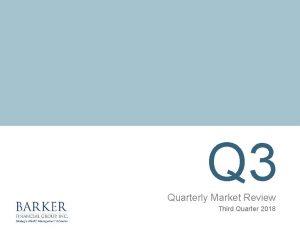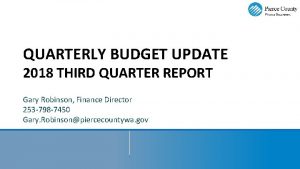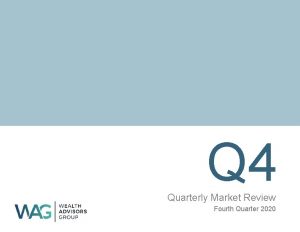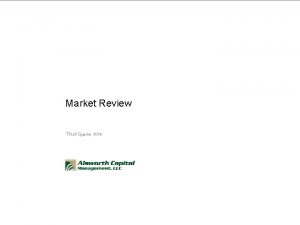Commentary Third Quarter 2020 Quarterly Market Update PRIMARY















































- Slides: 47

Commentary Third Quarter 2020 Quarterly Market Update PRIMARY CONTRIBUTORS Lisa Emsbo-Mattingly, CBE Jake Weinstein, CFA Andrew Garvey Director of Asset Allocation Research Analyst, Asset Allocation Research Associate, Asset Allocation Research Dirk Hofschire, CFA Jenna Christensen SVP, Asset Allocation Research Associate, Asset Allocation Research

Table of Contents Market Summary Economy/Macro Backdrop Asset Markets Long Term Themes

Market Summary

The sharp recovery in prices for riskier assets reflected abundant liquidity and hopeful expectations about reopening after the global shutdown. Economic conditions sequentially improved from extremely low levels, but progress has been uneven and will largely depend on COVID-19’s trajectory and on continued policy support. Uncertainty and volatility are likely to remain high, thus, a well-diversified portfolio may be as important as ever. MACRO Q 2 2020 • Global economy displayed sequential improvement as the re opening phase began. OUTLOOK • The worst of the recession is behind, but activity levels remain well below normal. • U. S. progress is tentative and uneven amid a pick up in new virus cases. • China’s recovery is ahead of the rest of the world, particularly its industrial activity. • The historic monetary and fiscal response remains supportive, but fiscal drag is a risk. • Policy actions address the near term deflationary shock, but they might presage a long term regime shift. 4 Diversification does not ensure a profit or guarantee against a loss. ASSET MARKETS • Dramatic rebound in riskier asset prices. • Policy decisions are likely to have an increasingly large influence on asset returns. • Tentative signs of economic stabilization warrant a relatively neutral near term asset allocation positioning. • Elevated market volatility is expected to continue due to uncertainty about the virus and economic outlook. SUMMARY Stimulus and Reopening Hopes Spurred Market Rebound

U. S. stocks posted their best quarterly results in more than 20 years, spearheading a global rally in riskier assets that trimmed year-to-date losses from the Q 1 sell-off. The decline in credit spreads boosted returns on corporate bonds, with longer-duration and higher-quality bonds posting the best year-to-date results. Gold benefited from negative real interest rates, but commodity prices overall remained laggards. U. S. Small Cap Stocks U. S. Mid Cap Stocks U. S. Large Cap Stocks Non U. S. Small Cap Stocks Emerging Market Stocks Non U. S. Developed Country Stocks Gold Q 2 2020 (%) YTD (%) 25. 4 24. 6 20. 5 19. 9 18. 1 14. 9 12. 9 13. 0 9. 1 3. 1 13. 1 9. 8 11. 3 17. 4 Real Estate Stocks Emerging Market Bonds High Yield Bonds U. S. Corporate Bonds Long Government & Credit Bonds Commodities Investment Grade Bonds Q 2 2020 (%) YTD (%) 11. 8 11. 2 9. 6 8. 2 6. 2 5. 1 2. 9 18. 7 1. 9 4. 8 12. 8 19. 4 6. 1 20 -Year U. S. Stock Returns Minus IG Bond Returns since 1946 Annualized Return Difference (%) 16% 12% 8% Average since 1946: 5% 4% 0. 7% 0% 4% 19 19 19 19 19 19 19 20 20 20 46 48 50 52 54 56 58 60 62 64 66 68 70 72 74 76 78 80 82 84 86 88 90 92 94 96 98 00 02 04 06 08 10 12 14 16 18 20 5 Past performance is no guarantee of future results. It is not possible to invest directly in an index. All indexes are unmanaged. See Appendix for important index information. Assets represented by: Commodities—Bloomberg Commodity Index; Emerging Market Bonds—JP Morgan EMBI Global Index; Emerging Market Stocks—MSCI EM Index; Gold—Gold Bullion, LBMA PM Fix; High Yield Bonds—ICE Bof. A High Yield Bond Index; Investment Grade Bonds—Bloomberg Barclays U. S. Aggregate Bond Index; Non U. S. Developed Country Stocks—MSCI EAFE Index; Non U. S. Small Cap Stocks—MSCI EAFE Small Cap Index; Real Estate Stocks—FTSE NAREIT Equity Index; U. S. Corporate Bonds—Bloomberg Barclays U. S. Credit Index; U. S. Large Cap Stocks—S&P 500 ® index; U. S. Mid Cap Stocks— Russell Midcap® Index; U. S. Small Cap Stocks—Russell 2000 ® Index; Long Government & Credit Bonds—Bloomberg Barclays Long Government & Credit Index. Source: Bloomberg Finance L. P. , Haver Analytics, Fidelity Investments Asset Allocation Research Team (AART), as of 6/30/20. SUMMARY Dramatic Recovery in Riskier Assets

U. S. stocks have tended to peak before or during a recession, decline amid the recession, then bottom and stage a recovery sometime thereafter. Compared with other recessionary sell-offs in recent decades, 2020 marked the swiftest initial drop as well as the quickest, sharpest bounce-back. Stocks have recovered so much ground during this recession that they might be pulling forward gains typically earned during the early-cycle phase. Stock Market Drawdowns during Recessions (1960─2020) 1960 1973 1980* 1981 1990 2001 2008 2020 Index: Peak = 100 110 100 90 80 70 60 Total Drawdown Length (Days) 50 Drawdown through Recession End Days to Return to Peak Average since 1960 2020 33% 34% 340 23 20% 8% (6/30/20) 756 40 0 30 60 90 120 150 180 210 240 270 Days since Peak 6 * Since the 1973 peak is not regained until after the 1980 recession, the 1980 line starts at its near term high on 2/20/1980. Index: S&P 500 Lines represent a 5 day moving average, table uses daily values, and 1973 recession not included in average for return to peak. All indexes are unmanaged. You cannot invest directly in an index. Past performance is no guarantee of future results. Source: Standard & Poor’s, Bloomberg Finance L. P. , Fidelity Investments (AART), as of 6/30/20 ®. 300 330 360 SUMMARY Fast Moving Stock Prices: Too Much Too Soon?

Massive government spending—including checks to many households and enhanced unemployment benefits— helped the personal savings rate to skyrocket in April, at a time when many venues where money could be spent remained closed. This dynamic prompted a burst of retail-investor stock trading. New Federal Reserve facilities for buying corporate bonds served as a welcome sign for borrowers, resulting in a record level of new issuance. Personal Savings and Government Stimulus Transfer Receipts from Gov't Corporate Bond New Issuance New Debt Issuance (Jan–May) Personal Savings Trillions Billions $7 $1, 200 $6 $1, 000 $5 $800 $4 $600 $3 $400 $2 $200 $1 7 May 20 Nov 19 May 19 Nov 18 May 18 Nov 17 May 17 Nov 16 May 16 Nov 15 May 15 $0 $0 2015 2016 2017 LEFT: Source: Bureau of Economic Analysis. Haver Analytics, Fidelity Investments (AART) as of 5/31/20. RIGHT: Source: SIFMA, Fidelity Investments (AART), as of 5/31/20. 2018 2019 2020 SUMMARY Monetary and Fiscal Stimulus Provided Boost to Technicals

Real Yields Deeply Negative, Inflation Expectations Stabilize SUMMARY U. S. 10 -year Treasury yields remained near record lows, held in check by weak economic activity, quantitative easing, and a global low-yield environment. The real cost of borrowing fell deeper into the negative during Q 2, offsetting a rise in inflation expectations from depressed levels. The most negative real yields in U. S. history occurred during periods of monetary accommodation and higher inflation in the late 1940 s and mid-’ 70 s. 10 -Year U. S. Government Bond Yields Inflation Expectations Real Yields Nominal Yield Q 2 2020 Yield Change (bps) Years with Low Real Yields Yield 4. 0% 3. 5% 1947 1974 8. 5% 1. 2% Inflation Expectations Real Yields Nominal Yield +47 -51 -4 3. 0% 2. 5% 2. 0% 1. 5% 1. 3% 1. 0% 0. 7% 0. 5% 0. 0% 8 Source: Bloomberg Finance L. P. , Fidelity Investments (AART), as of 6/30/20. Feb 2020 Oct 2019 Jun 2019 Feb 2019 Oct 2018 Jun 2018 Feb 2018 Oct 2017 Jun 2017 Feb 2017 Oct 2016 Jun 2016 Feb 2016 Oct 2015 Jun 2015 Feb 2015 Oct 2014 Jun 2014 Feb 2014 Oct 2013 Jun 2013 Feb 2013 Oct 2012 Jun 2012 Feb 2012 Oct 2011 Jun 2011 Feb 2011 Oct 2010 Jun 2010 1. 0% Jun 2020 -0. 7% 0. 5%

Economy/Macro Backdrop

Fidelity’s Asset Allocation Research Team (AART) believes that asset-price fluctuations are driven by a confluence of various factors that evolve over different time horizons. As a result, we employ a framework that analyzes trends among three temporal segments: tactical (short term), business cycle (medium term), and secular (long term). DYNAMIC ASSET ALLOCATION TIMELINE HORIZONS Secular (10– 30 years) Business Cycle (1– 10 years) Tactical (1– 12 months) Portfolio Construction Asset Class | Country/Region | Sectors | Correlations 10 For illustrative purposes only. Source: Fidelity Investments (AART), as of 6/30/20. ECONOMY Multi Time Horizon Asset Allocation Framework

Global activity shows early signs of improvement from extremely low levels. Near-term sequential progress is likely to continue as coronavirus-related restrictions on routine activities are lifted. China appears to be somewhat ahead of most major economies due to its earlier shutdown and reopening. While the worst of the recession appears to have passed for the U. S. and Europe as well, activity levels remain far below normal. Business Cycle Framework China* U. S. , Eurozone, UK, Canada, Australia Japan, South Korea, Brazil, Mexico, India Note: The diagram above is a hypothetical illustration of the business cycle. There is not always a chronological, linear progression among the phases of the business cycle, and there have been cycles when the economy has skipped a phase or retraced an earlier one. * A growth recession is a significant decline in activity relative to a country’s long term economic potential. We use the “growth cycle” definition for most developing economies, such as China, because they tend to exhibit strong trend performance driven by rapid factor accumulation and increases in productivity, and the deviation from the trend tends to matter most for asset returns. We use the classic definition of recession, 11 involving an outright contraction in economic activity, for developed economies. Source: Fidelity Investments (AART), as of 6/30/20. ECONOMY Tentative Economic Stabilization after Historic Declines

High Frequency Data Shows Uneven Progress ECONOMY Since COVID-19 lockdowns sent power demand declining at double-digit rates, the path to reopening and recovery has been jagged and varied across countries. China experienced the sharpest declines amid the toughest lockdown, but has since seen material improvement. Europe’s progress appears the most tentative, while the U. S. advance seemed to stall during June. High-Frequency Energy Demand Europe United States China Distance from Average 20% 10% 0% -2% -9% -12% 10% 20% 30% 6/29/20 6/22/20 6/15/20 6/8/20 6/1/20 5/25/20 5/18/20 5/11/20 5/4/20 4/27/20 4/20/20 4/13/20 4/6/20 3/30/20 3/23/20 3/16/20 3/9/20 3/2/20 2/24/20 2/17/20 2/10/20 2/3/20 1/27/20 50% 1/20/20 40% European energy demand is reflected by a five day moving average of daily electric loads, Chinese energy demand is reflected by a seven day moving average of daily coal consumption, and U. S. energy demand is reflected by weekly electric output. The distance from average for the U. S. and Europe is calculated as the current year’s data as a percentage above or below the 2017– 2019 weekly average. The distance from average for the China is calculated as the current year’s data as a percentage above or below the 2017– 2019 daily average indexed to the Chinese New Year. GDP weighted countries in Europe include: Italy, Germany, United Kingdom, Spain, Austria, and France. Source: CCTD, European Network of Transmission System Operators for Electricity, Edison Electric Institute, 12 Haver Analytics, Fidelity Investments (AART), as of 6/28/20.

China: An Industry Led Recovery China Industrial Activity China Consumer Confidence Index AART Industrial Production Diffusion Index PMI: New Export Orders Consumer Confidence Index Value: 100 = Neutral Sentiment 100% 75 130 90% 70 125 80% 65 70% 60 60% 55 50% 50 110 40% 45 105 30% 40 20% 35 10% 30 100 PMI: Purchasing Managers Index. A reading above 50 indicates the manufacturing economy is generally expanding; below 50 indicates it is generally contracting. AART Industrial Production Diffusion Index is a proprietary index based on industrial production data. Gray bars represent China growth recessions as defined by AART. LEFT: Source: China National Bureau of Statistics, Haver Analytics, Fidelity Investments (AART). AART Diffusion Index as of 5/31/20. PMI as of 6/30/2020. RIGHT: Index values above 100 denote optimism, values below 100 denote pessimism, and an index value 13 of 100 denotes neutral sentiment. Source: China National Bureau of Statistics, Haver Analytics, Fidelity Investments (AART), as of 5/31/20. Jun 20 Jun 19 Jun 18 Jun 17 Jun 16 Jun 15 90 Jun 14 95 Jun 13 25 115 Jun 12 0% Dec 05 120 Jun 11 PMI Jun 10 Percent of Industries in Expansion ECONOMY Boosted by government infrastructure stimulus and the move to reopen, China’s industrial production has largely recovered, although export-oriented industries still face weak global demand. The consumer sector appears mixed, with a supportive housing market but an uncertain employment outlook. China’s recovery is slowly gaining traction, but additional policy stimulus may be needed to sustain reacceleration.

After hitting record levels in March, new unemployment claims slowed as the U. S. started to reopen. With weekly claims still above 1 million and unemployment above 11%, labor markets likely will take time to heal. The CARES fiscal package boosted unemployment benefits by $600 per week and raised average incomes for low- and middle-income workers above their pre-virus levels, but those extra benefits are set to expire in July. U. S. Unemployment Claims Weekly Earnings of Unemployed Individuals Initial Claims With $600 CARES Benefit Millions With $250 Percent Above or Below Normal Income 7 0. 1 0. 09 6 100% 80% 0. 08 5 0. 07 4 3 0. 06 40% 0. 05 20% 0. 04 0% 0. 03 2 0. 02 Jun 20 Jun 19 Jun 18 Jun 17 Jun 16 Jun 15 Jun 14 Jun 13 Jun 12 Jun 11 Jun 10 Jun 09 Jun 08 Jun 07 1 0 60% 20% 0. 01 40% 0 60% Low Income Middle Income LEFT: Source: Census, Haver Analytics, Fidelity Investments (AART), as of 6/27/20. RIGHT: Workers receiving unemployment insurance. “With $250” is if extra benefit is reduced to that level after expiration of $600. Worker income cohorts are defined by percentiles: low Income (25 th percentile), middle income (50 th percentile), and high income (75 th percentile). Working paper “U. S. Unemployment Insurance Replacement 14 Rates During the Pandemic” by Ganong, Noel, and Vavra, Fidelity Investments (AART), as of 5/31/20. High Income ECONOMY Unemployment Shock Followed by Improvement, Support

As the U. S. economy started to reopen during Q 2, consumers’ expectations relative to their assessment of thencurrent conditions improved significantly. This trend typically begins during recession and lasts into the earlycycle phase. Industries most directly impacted by the virus—such as travel, leisure, restaurants, and hotels— may be the most difficult to fully reopen, and they account for roughly 20% of U. S. jobs and economic output. Consumer Sentiment Sectors Most Impacted by COVID-19 Consumer Expectations/Present Situation Largest Affected Industry Ratio Share 7 25% Other 6 20% 5 15% 4 3 Restaurants and Hotels Leisure and Hospitality 10% 2 5% 1 0 0 197 198 198 199 199 200 200 201 201 202 8 1 4 7 0 3 6 9 2 5 8 1 4 7 0 0% GDP LEFT: Gray bars represent U. S. recessions as defined by NBER. Source: Conference Board, Haver Analytics, Fidelity Investments (AART), as of 6/30/20. RIGHT: Other industries most impacted shaded in blue include: For GDP: Recreation Services, Autos, Transportation Services, Recreation Goods, Clothing, Gasoline, Furnishings. For Employment: Retail, Transportation Source: Conference Board, NBER, Haver 15 Analytics, Fidelity Investments (AART), as of 2/29/20. Private Employment ECONOMY Consumers Expect Improvement, but Reopening Is Difficult

Among States, “Fast” Reopeners Stall U. S. Progress New COVID-19 Cases ECONOMY In June, new COVID-19 cases climbed in states that had quickly relaxed social distancing measures, whereas formerly hard-hit states such as New York experienced a decline in new cases. High-frequency data—such as businesses reopened and employee hours worked—showed improvements in U. S. economic activity from historic lows. However, progress stalled among fast-reopening states and remains far below normal levels. Daily Data in “Fast” Reopening States "Fast" Reopening States "Slow" Reopening States April Trough 6/26/20 6/18/20 Hours and Businesses (0 = Baseline) Cases (Five Day Moving Average) Year Over Year 0 8000 0% 10% 20% 30% 40% 4000 50% 3000 60% 70% 80% 90% 7000 6000 5000 2000 6/30/20 6/23/20 6/16/20 6/9/20 6/2/20 5/26/20 5/19/20 5/12/20 5/5/20 4/28/20 4/21/20 4/14/20 4/7/20 3/31/20 3/24/20 3/17/20 3/10/20 0 3/3/20 1000 100% Hours Worked by Local Businesses Open. Table Employees Open Reservations Yo. Y “Fast” reopening states include Arizona, Florida, Georgia, and Texas. “Slow” reopening states include Massachusetts, New York, and New Jersey. LEFT: Source: Johns Hopkins University, Haver Analytics, Fidelity Investments (AART), as of 7/3/20. RIGHT: Baseline is defined as the median for that day of the week during the period 1/4/20– 1/31/20. Source: Open. Table, Homebase, Haver Analytics, Fidelity Investments (AART), 16 as of 6/26/20.

2020 earnings are expected to decline nearly 20%—about average for the previous five recessions. Consensus estimates are for S&P 500 EPS to return to pre-virus levels by the end of 2021—a much faster rate of recovery to pre-recession levels than the historical average of closer to three years. Considering the damage to the economy and uncertainty about the path of recovery, we believe profit growth may be slower than anticipated. S&P 500 Earnings Growth Estimates 2020 S&P 500 EPS Progression in Recession Average since 1980 2020– 22 Consensus Estimate 2021 Year Over Year 30% 20% ECONOMY Market Expects a Relatively Quick Earnings Recovery 2007– 2008 Index: Start of Recession = 100 120 Expected EPS (Calendar Year) 2019 (actual) $162 2020 $126 2021 $159 2022 $187 110 10% 90 0% 80 70 10% 60 20% 30% Jun 19 50 40 Sep 19 Dec 19 Mar 20 Jun 20 12 9 6 3 0 3 6 9 12 15 18 21 24 27 30 33 36 Months (t=0 is start of recession) LEFT AND RIGHT: EPS: Earnings per share. Past performance is no guarantee of future results. Source: Bloomberg Finance L. P. , Fidelity 17 Investments (AART), Haver Analytics as of 6/25/20.

Inflation Drop Likely Short Lived; Consensus Low for Long ECONOMY Core CPI dropped by nearly half in recent months, but alternative inflation measures from regional Fed banks fell much less and suggested the biggest disinflation is behind us. We expect inflation to remain range-bound in the near term amid a weak economy, but longer-term inflation risks may be higher than anticipated—market expectations for long-term inflation are lower than they were during the deflationary GFC of 2008. U. S. Inflation Expectations Measures of U. S. Inflation May 2020 Dec 2019 Year Over Year Expected CPI Year Over Year 2. 75% 2. 50% 2. 25% 2. 00% 1. 75% 1. 50% 1. 25% 1. 00% 0. 75% 0. 50% June 2010 GFC June 2020 0. 50% Cleveland Fed Atlanta Fed New York Fed Core CPI 1 2 3 4 5 6 7 Years LEFT: CPI: Consumer Price Index. Core CPI excludes Food and Energy. Cleveland Fed: Cleveland 16% Trimmed Mean CPI, Atlanta Fed: Sticky CPI, New York Fed: Underlying Inflation Gauge. Source: Federal Reserve Board, Bureau of Labor Statistics, Haver Analytics, Fidelity Investments (AART), as of 5/31/20. RIGHT: GFC: Global Financial Crisis. Inflation curves derived from Inflation swaps. Source: Bloomberg Financial, Fidelity 18 Investments (AART), as of 6/30/20. 8 9 10 20 30

Response May Not Resolve Pre Existing Vulnerabilities U. S. Corporate Debt Household Financial Assets and Income Non Financial Corporate Credit/Revenues Financial Assets Ratio 120% ECONOMY While both the policy response and the market recovery have been dramatic, some of the near-term remedies may have exacerbated pre-COVID underlying weaknesses. The Fed’s emergency lending facilities have driven corporate debt—already at record levels—even higher. In addition, gains in financial assets tend to benefit wealthier households but not lower-income tiers, which face greater economic distress. Bottom 50% Household Income Share of Disposable Income 0 Share of Household Income 600% 24% 550% 22% 500% 20% 450% 18% 400% 16% 350% 14% 300% 1976 1981 1986 1991 1996 2001 2006 2011 2016 12% 0 110% 0 0 100% 0 0 90% 0 0 80% 0 0 70% 0 1993 1996 1999 2002 2005 2008 2011 2014 2017 2020 LEFT: Gray bars represent U. S. recessions as defined by NBER. Source: Federal Reserve Board, NBER, Bureau of Economic Analysis, Haver Analytics, Fidelity Investments (AART), as of 3/31/20. RIGHT: The 50% of households with the lowest incomes. Source: Federal Reserve Board, 19 Bureau of Economic Analysis, World Inequality Data, Haver Analytics, Fidelity Investments (AART), as of 12/31/18

Liquidity Injections Exceed Previous Episodes of Easing ECONOMY The Federal Reserve delivered massive monetary accommodation, pushing its balance sheet above $7 trillion by the end of Q 2. The Fed ramped up purchases of Treasuries and MBS, bought municipal and corporate bonds through new facilities, and also provided support via other activities. Europe and Japan increased their QE programs, with global central banks injecting more than twice the liquidity of previous easing periods. Central Bank Balance Sheets Estimate Total UK Japan Eurozone Billions (12 Month Change) $5, 000 $4, 000 $3, 000 $2, 000 $1, 000 QE: Quantitative Easing. Source: Federal Reserve, Bank of Japan, European Central Bank, Bank of England, Haver Analytics, Fidelity Investments 20 (AART), as of 5/31/20. May 2020 Nov 2019 May 2019 Nov 2018 May 2018 Nov 2017 May 2017 Nov 2016 May 2016 Nov 2015 May 2015 Nov 2014 May 2014 Nov 2013 May 2013 Nov 2012 May 2012 Nov 2011 $1, 000 May 2011 $0

Unprecedented Fiscal Response Will Likely Need More ECONOMY By May, the federal government had approved roughly $3 trillion of emergency funds, which provided a crucial bridge to economic activity during the shutdown but also ballooned the fiscal deficit to roughly 18% of GDP. Amid a slow reopening and severe budget shortfalls at the state and local government level, ongoing federal support may be needed to avoid a significant fiscal drag on the economy similar to the post-GFC expansion. U. S. Federal Fiscal Deficit and Government Impact on GDP State and Local Government Federal Budget Deficit Contribution to GDP Percent of GDP 1. 00% 10% 0. 75% 5% 0. 50% 0% 0. 25% 0. 00% 5% 0. 25% 10% 0. 50% 15% Source: CBO, BEA, Haver Analytics. 2020 and 2021 Budget Deficits are CBO projections ( https: //www. cbo. gov/system/files/2020 04/56344 CBO 21 presentation. pdf ), Fidelity Investments (AART). 2021 2020 2019 2018 2017 2016 2015 2014 2013 2012 2011 2010 2009 1. 00% 2008 0. 75% 20%

The deepening U. S. –China geopolitical rivalry makes broader agreement on bilateral commercial issues less tractable and raises the risk that flashpoints will lead to escalation. Policy actions in 2020 may be relatively contained, but the COVID-19 aftermath could lead to a medium-term rise in industrial policies aimed at selfsufficiency, more restrictive travel and immigration, and continued bipolarization of the global IT industry. U. S. -China Relationship Policy Tools of De-Globalization Policy Action Categories Geopolitical Rivalry Military Hegemony in Asia Strategic Competition Trade Economic Advantage in Key Areas Consumer and Other Goods Bilateral Flashpoints • Hong Kong • Detention camps • Taiwan • South China Sea Industrial Policy Issues • IT sector • Health care • Supply chains Broad Economic Tariffs/ Market Access • Phase 1 ag deal Investment Example Tariff/Trade Barriers Raise tariffs to reduce imports Export and FDI Restrictions Curtail high tech exports Industrial Policies Mandate supply chain onshoring Immigration/ Human Mobility Tighter borders Financial Restrictions/ Penalties U. S. sanctions; tax policies Info/Data Restrictions China's firewall Portfolio Investment Restrictions U. S. de lists Chinese ADRs Politicized Debt Action Selective U. S. default 22 Ag: Agriculture. FDI: Foreign direct investment. ADR: American depositary receipt. Source: Fidelity Investments (AART), as of 6/30/20. ECONOMY U. S. –China Tensions Spur De Globalization Pressures

Fidelity’s Business Cycle Board, composed of portfolio managers responsible for a variety of global asset allocation strategies, believes that policy actions are playing a larger role in driving economic and market expectations than they have in the past. Board members hold a wide range of views, but they emphasize the need for a disciplined investment strategy, and some see opportunities within non-U. S. asset categories. Business Cycle Risks U. S. is in process of emerging from a brief but sharp recession The recovery remains highly uncertain given the size and exogenous nature of the COVID shock Policymakers providing abundant support to markets and economy Policy actions are playing a larger role in driving financial market performance than in past cycles Asset Allocation Implications Emphasize focus on diversified and disciplined investment strategies Members hold a wide range of views, but see opportunities within asset classes Opportunities include non U. S. assets, U. S. small cap and value equities, TIPS, and gold 23 For illustrative purposes only. Diversification does not ensure a profit or guarantee against a loss. Source: Fidelity Investments (AART), as of 6/30/20. ECONOMY Outlook: Market Assessment

Asset Markets

Almost all asset categories posted strong Q 2 recoveries from their steep Q 1 declines. Returns for most equity categories remained negative on a year-to-date basis, but U. S. growth and technology stocks moved into positive territory. Riskier credit segments such as emerging-market debt and leveraged loans led during Q 2, but longer-duration and higher-quality bonds remained ahead and in positive territory for the year. International Equities and Global Assets Total Return U. S. Equity Styles Total Return Q 2 YTD Growth 28. 0% 9. 0% Small Caps 25. 4% 13. 0% Mid Caps 24. 6% 9. 1% Large Caps 20. 5% 3. 1% Value 14. 6% 16. 7% U. S. Equity Sectors Total Return Q 2 YTD ACWI ex USA 16. 1% 11. 0% Canada 20. 2% 12. 9% EAFE Small Cap 19. 9% 13. 1% Europe 15. 3% 12. 8% EAFE 14. 9% 11. 3% Japan 11. 6% 7. 1% Latin America 19. 1% Fixed Income Total Return Q 2 YTD EM Debt 11. 2% 1. 9% Leveraged Loan 9. 7% 4. 6% High Yield 9. 6% 4. 8% Credit 8. 2% 4. 8% Long Govt & Credit 6. 2% 12. 8% TIPS 4. 2% 6. 0% CMBS 4. 0% 5. 2% 35. 2% ABS 3. 5% 3. 3% Q 2 YTD EMEA 18. 9% 21. 4% Aggregate 2. 9% 6. 1% Consumer Discretionary 32. 9% 7. 2% Emerging Markets 18. 1% 9. 8% Municipal 2. 7% 2. 1% Info Tech 30. 5% 15. 0% EM Asia 17. 8% 3. 5% Agency 0. 9% 5. 1% Energy 30. 5% 35. 3% Gold 12. 9% 17. 4% MBS 0. 7% 3. 5% Materials 26. 0% 6. 9% Commodities 5. 1% 19. 4% Treasuries 0. 5% 8. 7% Communication Services 20. 0% 0. 3% Industrials 17. 0% 14. 6% Health Care 13. 6% 0. 8% Real Estate 13. 2% 8. 5% Financials 12. 2% 23. 6% Consumer Staples Utilities 8. 1% 2. 7% U. S. Equity Factors Total Return Q 2 YTD Size 21. 7% 14. 1% 5. 7% Momentum 21. 2% 0. 8% 11. 1% Quality 20. 4% 1. 9% Value 19. 8% 10. 4% Yield 19. 0% 14. 3% Low Volatility 17. 7% 4. 4% EM: Emerging Markets. EMEA: Europe, the Middle East, and Africa. For indexes and other important information used to represent above asset categories, see Appendix. Past performance is no guarantee of future results. It is not possible to invest directly in an index. All indexes are unmanaged. Sector returns represented by S&P 500 sectors. Sector investing involves risk. Because of its narrow focus, sector investing may be 25 more volatile than investing in more diversified baskets of securities. Source: Bloomberg Finance L. P. , Fidelity Investments (AART), as of 6/30/20. ASSET MARKETS Sharp Recovery from Q 1 Losses across Categories

The business cycle can be a critical determinant of asset performance over the intermediate term. Stocks have consistently performed better earlier in the cycle, whereas bonds tend to outperform during recession. While we believe a business cycle approach to actively managed asset allocation can add value, portfolio returns are expected to even out over the long term (>10 years), regardless of the starting point of the cycle phase. Asset Class Performance by Cycle Phase (1950– 2018) U. S. Stocks IG Bonds 10 -Year Portfolio Return Distribution by Cycle Phase Starting Point Cash Annualized Nominal Return Annualized Real Return 25% 8% 20% 6% 75 th percentile 15% 4% 10% Median 5% 2% 25 th percentile 0% 0% 5% Sample Portfolio: 36% Domestic Equity • 24% Foreign Equity • 30% IG Bonds • 10% HY Bonds 2% 10% Early Mid Late Recession Early Mid For illustrative purposes only. Past performance is no guarantee of future results. Diversification does not ensure a profit or guarantee against a loss. It is not possible to invest directly in an index. All indexes are unmanaged. See Appendix for important index information. Fidelity proprietary analysis based on Monte Carlo simulations using historical index returns. Domestic Equity: Dow Jones U. S. Total Stock Market Index; Foreign Equity: MSCI ACWI ex USA Index: Investment Grade (IG) Bonds: Bloomberg Barclays U. S. Aggregate Bond Index; High Yield (HY) Bonds: ICE 26 Bof. A U. S. High Yield Index. Source : Fidelity Investments, Morningstar, Bloomberg Barclays; data as of 6/30/20. Late Recession ASSET MARKETS Business Cycle Important, but Dissipates in the Long Run

Earnings growth across all regions continued to slide during Q 2, with trailing profit growth in U. S. , non-U. S developed, and emerging markets all deep in contraction. Forward estimates, however, point to market expectations of a recovery in earnings growth over the next 12 months, led by EM moving back into positive territory. ASSET MARKETS Expectations Are for Global Earnings Growth to Improve Global EPS Growth (Trailing 12 Months) EM DM U. S. Percent 40% 30% 20% Forward EPS 10% 5. 3% 0% 0. 1% -4. 9% 10% 20% 30% 40% Jun 12 Jun 13 Jun 14 Jun 15 Jun 16 Jun 17 Jun 18 Past performance is no guarantee of future results. DM: Developed Markets. EM: Emerging Markets. EPS: Earnings per share. Forward EPS: 27 Next 12 months expectations. Source: MSCI, Bloomberg Finance L. P. , Fidelity Investments (AART), as of 6/30/20. Jun 19 Jun 20

Equity Valuations Back to Pre Pandemic Levels ASSET MARKETS The rally in stock prices and decline in earnings drove global equity valuations higher during Q 2, back near their early 2020 levels. The rise in price-to-earnings (P/E) ratios was broad-based across regions, with the U. S. and emerging-market P/E ratios finishing the quarter above their long-term historical averages. U. S. forward P/E ratios also are elevated, but EM forward valuations remain below their long-term norm. Global Stock Market P/E Ratios DM Trailing P/E EM Trailing P/E US Trailing P/E Forward P/E Ratio 25 U. S. DM Long-Term Average 20 U. S. Long-Term Average DM 15 EM 10 EM Long-Term Average 5 0 2005 2008 2011 2014 2017 DM: Non U. S. Developed Markets. EM: Emerging Markets. Past performance is no guarantee of future results. It is not possible to invest directly in an index. All indexes are unmanaged. See Appendix for important index information. Price to earnings ratio (P/E): stock price divided by earnings per share. Also known as the multiple, P/E gives investors an idea of how much they are paying for a company’s earnings power. Long term average P/E for Emerging Markets includes data for 1988– 2017; for Non U. S. Developed Markets, 1973– 2016; for the United States, 1926– 2017. Indexes: DM— 28 MSCI EAFE Index; EM—MSCI EM Index; United States—S&P 500. Source: Bloomberg Finance L. P. , Fidelity Investments (AART), as of 6/30/20. 2020

Cyclically adjusted P/E (CAPE) ratios for international developed-market and emerging-market equities remained below U. S. valuations, providing a relatively favorable long-term backdrop for non-U. S. stocks. In Q 2, the U. S. dollar depreciated against many of the world’s major currencies; nevertheless, U. S. dollar valuations remain relatively expensive overall. Cyclically Adjusted P/Es 5/31/20 Valuation of Major Currencies vs. USD 20 Year Range Last 12 Month Range 6/30/20 Shiller CAPE Valuation of Real Exchange Rates 100 10% 90 5% 80 Expensive vs. $ 0% 70 5% 60 Cheap vs. $ 10% 50 15% 40 20% 30 25% 10 30% 0 35% Russia Turkey Spain South Korea UK Indonesia China Australia EM Brazil Italy Mexico Germany Philippines DM France Canada Japan India U. S. 20 GBP JPY CAD DM: Developed Markets. EM: Emerging Markets. Past performance is no guarantee of future results. It is not possible to invest directly in an index. All indexes are unmanaged. See Appendix for important index information. LEFT: Price to earnings (P/E) ratio (or multiple): stock price divided by earnings per share, which indicates how much investors are paying for a company’s earnings power. Cyclically adjusted earnings are 10 year averages adjusted for inflation. Source: Fact. Set, countries’ statistical organizations, Haver Analytics, Fidelity Investments (AART), as of 5/31/20. RIGHT: GBP—British pound; JPY—Japanese yen; CAD—Canadian dollar; EUR—euro; CNY—Chinese yuan. 29 Source: Federal Reserve Board, Haver Analytics, Fidelity Investments (AART), as of 6/30/20. EUR CNY ASSET MARKETS Non U. S. Equity and Forex Valuations Relatively Attractive

Market expectations for inflation—represented by breakeven rates for TIPS—climbed from decade-low levels but remain at the low end of their historical range. Oil prices recovered during Q 2 but remain below pre-virus levels and also, on an inflation-adjusted basis, low relative to history. Unlike valuations for many other asset classes, prices among inflation-resistant asset categories remain relatively inexpensive. U. S. Treasury Breakeven Inflation Rates 10 Year ASSET MARKETS Inflation Protection Remains Inexpensive Real Oil Price LT Average (Since 1998) WTI Crude Oil Yield Inflation Adjusted Price (March 2020 Dollars) 3. 0% $160 $140 2. 5% $120 2. 0% $100 1. 5% $80 $60 1. 0% $40 0. 5% 2020 2019 2018 2017 2016 2015 2014 2013 2012 2011 0. 0% 2010 $20 $0 19 19 19 19 20 20 20 74 76 78 80 82 84 86 88 90 92 94 96 98 00 02 04 06 08 10 12 14 16 18 20 LEFT: TIPS: Treasury Inflation Protected Securities. SOURCE: Haver Analytics, Fidelity Investments (AART), as of 6/30/20. RIGHT: Source: 30 CME, Bureau of Labor Statistics, Haver Analytics, Fidelity Investments (AART), as of 6/30/20.

A disciplined business-cycle approach to sector allocation seeks to generate active returns by favoring industries that may benefit from cyclical trends. Economically sensitive sectors historically have performed better in the early and mid-cycle phases of an economic expansion. Meanwhile, companies in defensive sectors with relatively more stable earnings growth have tended to outperform in recession. ASSET MARKETS Business Cycle Approach to Equity Sectors Business-Cycle Approach to Sectors Sector Financials Real Estate Consumer Discretionary Information Technology Industrials Materials EARLY CYCLE Rebounds MID CYCLE Peaks LATE CYCLE Moderates RECESSION Contracts + ++ ++ + ++ ++ + Consumer Staples Health Care Energy Communication Services Utilities Economically sensitive sectors may tend to outperform, while more defensive sectors have tended to underperform. + Making marginal portfolio allocation changes to manage drawdown risk with sectors may enhance risk adjusted returns during this cycle. Defensive and inflation resistant sectors tend to perform better, while more cyclical sectors underperform. Past performance is no guarantee of future results. Sectors as defined by GICS. White line is a theoretical representation of the business cycle as it moves through early, mid, late, and recession phases. Green and red shaded portions above respectively represent over or underperformance relative to the broader market; unshaded (white) portions suggest no clear pattern of over or underperformance. Double +/– signs indicate that the sector is showing a consistent signal across all three metrics: full phase average performance, median monthly difference, and cycle hit rate. 31 A single +/– indicates a mixed or less consistent signal. Return data from 1962 to 2016. Source: Fidelity Investments (AART), as of 6/30/20. ++ ++ ++ Since performance is generally negative in recessions, investors should focus on the most defensive, historically stable sectors.

On a cyclical basis, the relative performance of value stocks has tended to correlate generally with the direction of the global economy and, in particular, with commodity prices, which may be bottoming after the worldwide COVID-19 shutdown. Meanwhile, after a decade of trailing other leading factors and styles, value’s relative valuations are at their most attractive in roughly 20 years. Value Relative Performance vs. Commodity Prices Value vs. Growth Performance Price-to-Book Valuation Spreads Growth vs. Value CRB Raw Industrials Index Ratio Index 540 1. 04 520 ASSET MARKETS Value Equity More Attractive after Long Underperformance P/B Ratio 10 9 8 1. 02 1. 00 500 7 480 6 5 0. 98 460 0. 96 440 0. 94 420 4 3 2 LEFT: Gray bars represent U. S. recessions as defined by NBER. Asset classes represented by Value: Fidelity Value ETF; Growth: Russell 1000 ® Growth Index; Commodity Prices: CRB Raw Industrials Index. Source: Federal Reserve Board, NBER, Haver Analytics, Bloomberg Finance L. P. , Fidelity Investments (AART), as of 6/30/20. RIGHT: Asset classes represented by Growth: Russell 1000 ® Growth Index; Value: Russell 1000 ® Value Index. Source: Bloomberg Finance L. P. , Fidelity Investments (AART), as of 6/30/20. Past performance is no guarantee of future results. All indexes are unmanaged. You cannot invest directly in an index. Unlike mutual funds, ETF shares are bought and sold at market price, 32 which may be higher or lower than their NAV, and are not individually redeemed from the fund. 2020 2018 2016 2014 2012 2010 2008 2006 2004 2002 2000 0 1998 400 1996 Jun 20 Mar 20 Dec 19 Sep 19 Jun 19 Mar 19 Dec 18 Sep 18 Jun 18 Mar 18 Dec 17 Sep 17 Jun 17 Mar 17 Dec 16 0. 92 Sep 16 1

Tighter Spreads Pushed Bond Yields to Record Lows ASSET MARKETS After a steep rise last quarter, credit spreads tightened during Q 2, but remained elevated relative to their longterm averages. Massive central bank accommodation in both the Treasury and credit markets put downward pressure on both rates and spreads, helping push bond yields in high-quality debt categories down to their lowest levels on record. Fixed Income Yields and Spreads (1993– 2020) Treasury Rates Credit Spread Yield Percentile Spread Percentile Yield and Spread Percentiles 10% 100% 86% 9% 78% 8% 7% 90% 76% 80% 67% 73% 70% 58% 6% 60% 5% 50% 4% 40% 26% 3% 30% 2% 1% 20% 5% 0% 1% U. S. Aggregate Bond MBS 0% 0% 0% 10% 0% Long Gov/Credit Corporate Investment Grade Corporate High Yield Past performance is no guarantee of future results. It is not possible to invest directly in an index. All indexes are unmanaged. See Appendix for important index information. Percentile ranks of yields and spreads based on historical period from 1993 to 2020. MBS: mortgage backed 33 securities. Source: Bloomberg Barclays, Bank of America Merrill Lynch, JP Morgan, Fidelity Investments (AART), as of 6/30/20. Emerging Market Debt

Long-Term Themes

The performance of different assets has fluctuated widely from year to year, and the magnitude of returns can vary significantly among asset classes in any given year—even among asset classes that are moving in the same direction. A portfolio allocation with a variety of global assets illustrates the potential benefits of diversification. Periodic Table of Returns Past performance is no guarantee of future results. Diversification/asset allocation does not ensure a profit or guarantee against loss. It is not possible to invest directly in an index. All indexes are unmanaged. See Appendix for important index information. Asset classes represented by: Commodities—Bloomberg Commodity Index; Emerging Market Stocks—MSCI Emerging Markets Index; Non U. S. Developed Country Stocks—MSCI EAFE Index; Growth Stocks—Russell 3000 Growth Index; High Yield Bonds—ICE Bof. A U. S. High Yield Index; Investment Grade Bonds—Bloomberg Barclays U. S. Aggregate Bond Index; Large Cap Stocks— S&P 500 index; Real Estate/REITs—FTSE NAREIT All Equity Total Return Index; Small Cap Stocks—Russell 2000 Index; Value Stocks— 35 Russell 3000 Value Index. Source: Morningstar, Standard & Poor’s, Haver Analytics, Fidelity Investments (AART), as of 6/30/20. LONG TERM Performance Rotations Underscore Need for Diversification

Secular Forecast: Slower Global Growth, EM to Lead LONG TERM Slowing labor force growth and aging demographics are expected to tamp down global growth over the next two decades. We expect GDP growth of emerging countries to outpace that of developed markets over the long term, providing a relatively favorable secular backdrop for emerging-market equity returns. Real GDP 20 -Year Growth Forecasts vs. History Developed Markets Last 20 Years Emerging Markets Annualized Rate 10% Global Real GDP Growth 9% Last 20 years 20 -year forecast 2. 7% 2. 1% 8% 7% 6% 5% 4% 3% 2% Past performance is no guarantee of future results. EM: Emerging Markets. GDP: Gross Domestic Product. 36 Source: OECD, Fidelity Investments (AART), as of 6/30/20. India Indonesia Philippines Malaysia South Africa Colombia Peru Mexico China Thailand Brazil Turkey Russia Sweden Australia Canada South Korea UK Netherlands France Germany Japan Spain Italy 0% U. S. 1%

We believe the longstanding global regime of relatively stable and investment-friendly policies, politics, and regulation is nearing an end. Rising populism, geopolitical destabilization, and de-globalization pressures are key drivers of this change. We expect greater government intervention may inhibit corporate profitability, distort market signals, and lead to higher political risk in investment decisions throughout the world. Regime Shift Driven by Powerful Underlying Dynamics Rising Populist Demands Geopolitical Instability Anti Globalization Pressure Widespread Aging Demographics Unprecedented Accumulation of Debt 37 Source: Fidelity Investments (AART), as of 6/30/20. Policy Dynamic Expected Shift Monetary • • Globalization • Trade, capital, and labor flows more restricted • Weaponized economic measures for geopolitical ends Fiscal • More permissive of large deficits and rising debt levels Regulatory • Trend toward greater interventionism Political risk • More commonplace in economic and commercial affairs Increased political influence on decisions Sustained financial repression More active role in financial markets More permissive of inflation LONG TERM Secular: Rising Policy and Political Risk

Demographic Deterioration Exacerbates Fiscal Pressures Demographic Support Ratio Japan Eurozone U. S. Gross Government Debt Current Workers/Retirees % of GDP 8 400% 7 350% 6 LONG TERM For most advanced economies, deteriorating demographic trends will only get worse in coming decades, with fewer new workers to support a growing number of retirees. This creates even greater fiscal pressure due to rising spending on pensions and health care. The already elevated levels of government debt/GDP are likely to rise much further, with some major economies on pace to surpass the highest debt levels ever recorded. 20 year Forecast 300% Highest level on record* 250% 5 200% 4 150% LEFT: The demographic support ratio is calculated as the number of workers (15 64 years old)/The number of retirees (65 and older). Source: United Nations, Haver Analytics, Fidelity Investments (AART), as of 10/31/19. RIGHT: *This level attained by the UK (1821), Netherlands (1834), France (1944), and Japan (1945). Forecasts by Fidelity Investments (AART). Source: International Monetary Fund, United Nations, Fidelity 38 Investments (AART), as of 5/31/20. Japan Spain Italy France 0% Germany 1 1980 1985 1990 1995 2000 2005 2010 2015 2020 2025 2030 2035 2040 50% UK 2 100% US 3

After decades of rapid global integration, economic openness stalled in recent years amid geopolitical shifts and domestic political pressures in many advanced economies. This poses risks for countries, industries, and companies that benefited most from the rise of a rules-based global order. The more that domestic politics and location matter, the greater the benefits and active opportunities from global asset diversification may be. Trade Globalization Global Imports/GDP Ratio 25% Secular Trends for Asset Markets • Less rules based and less market oriented global system More Globalized • Pressure on corporate profit margins • Geopolitical Inflationary pressures Strategic 20% Rivalry Trade Competition • Lower global asset price correlations • Military IT Sector/ Consumer Hegemony Advanced and Other Active opportunities—location and politics in Asia Industrials Goods matter more 15% 10% Less Globalized 5% 19 19 19 19 20 20 62 65 68 71 74 77 80 83 86 89 92 95 98 01 04 07 10 13 16 19 39 Source: International Monetary Fund (IMF), World Bank, Haver Analytics, Fidelity Investments (AART), as of 12/31/19. LONG TERM Secular Trend: De Globalization

Over the past decade, global central banks have continued to use extraordinary monetary accommodation. These policies have had mixed and unintended effects on the global economy, including increased risk in financial systems, deflationary impulses, and a weak consumer response. With many investors having grown accustomed to routine intervention, central banks may find it increasingly difficult to normalize their policies. Extraordinary Monetary Policy Goals vs. Consequences Intended Central Bank Goals Unintended Consequences Substitution effect Income effect Ease credit conditions Price controls Reduce debt-service burden Weaker productivity Improve export competitiveness Currency wars Consumption up Savings up Bank lending down Lower interest expense Less-productive firms stay in business Weaker currency Limited impact on currency 40 Source: Fidelity Investments (AART), as of 6/30/20. LONG TERM Unintended Consequences of Extraordinary Monetary Policy

The dramatic worldwide rise in public and private debt in recent decades is a reflection of monetary and fiscal policymakers’ proclivity to use low interest rates and government support to attempt to boost growth rates. While technology and other factors have kept inflation in check, we believe greater policy experimentation and “peak globalization” trends will eventually cause long-term inflation to rise faster than expected. Global Debt as a Share of GDP Public Possible Secular Impacts to Inflation Private Percent Secular Factors 250% Possible Developments Fed targets higher inflation 200% Policy More stimulative fiscal policy 150% Elderly people: Aging Demographics 100% Spend less (reducing demand) Work less (reducing supply) 2018 2008 1998 1988 1978 1968 1958 More robots, Amazon effect 1948 Technological Progress 1938 0% 1928 More expensive goods/labor 1918 Peak Globalization 1908 50% LEFT: Source: Bank of International Settlements, International Monetary Fund, Maddison Project, Fidelity Investments (AART), and the Jord à Schularick Taylor Macrohistory Database, compiled by Oscar Jordà, Moritz Schularick, and Alan M. Taylor. Accessed through www. macrohistory. net, 41 as of 12/31/18. RIGHT: Source: Fidelity Investments (AART), as of 3/31/20. Risks to Inflation LONG TERM Rising Debt: Will Policy Response Be Inflationary?

Market Downturns Can Cause Investors to De Risk LONG TERM Data from millions of retirement-plan participants illustrates how investor behavior can change under varying market conditions. During past bear markets, many long-term investors reduced their equity allocation and then took years to ramp back up to their prior equity-contribution rates. Excessive focus on short-term market volatility may hamper the ability to achieve the objectives of a sound, diversified, long-term investment plan. Fidelity Plan Participants’ Contribution to Equities S&P 500 Percentage of New Contributions to Stocks Price Contributions 3400 85% 3200 3000 2800 80% 2600 2400 2200 2000 75% 1800 1600 1400 70% 1200 1000 42 Data from Fidelity’s recordkeeping platform, which services more than 16 million corporate defined contribution (DC) participants. Stock contributions: the percentage of all new directed deferrals (contributions) into stocks by participants via the available investment options in defined contribution plans administered by Fidelity Investments. Shaded areas represent periods when the stock market (S&P 500 index) fell by 20% or more peak to trough. Diversification does not ensure a profit or guarantee against loss. Standard & Poor’s, Bloomberg Finance L. P. , Fidelity Investments, as of 3/31/20. 2020 2019 2018 2017 2016 2015 2014 2013 2012 2011 2010 2009 2008 2007 2006 2005 2004 2003 2002 2001 600 2000 800 65%

Myopic loss aversion describes a common bias in which greater sensitivity to losses than to gains is compounded by the frequent evaluation of outcomes. Historically, investors who review their portfolios more frequently have tended to shift toward more conservative exposures, as increased monitoring raises the likelihood of seeing (and reacting to) a loss. Impact of Feedback Frequency on Investment Decisions Monthly Yearly Stocks 41% Bonds 30% Bonds 59% In a study, subjects were assigned simulated conditions that were similar to making portfolio decisions on a monthly or yearly basis. Source: Thaler, R. H. , A. Tversky, D. Kahneman, and A. Schwartz. “The Effect of Myopia and Loss Aversion on Risk Taking: An Experimental Test. ” The Quarterly 43 Journal of Economics 112. 2 (1997), used by permission of Oxford University Press; Fidelity Investments (AART), as of 6/30/20. Stocks 70% LONG TERM Myopic Loss Aversion Prompts Risk Averse Behavior

Appendix: Important Information presented herein is for discussion and illustrative purposes only and is not a recommendation or an offer or solicitation to buy or sell any securities. Views expressed are as of the date indicated, based on the informa tion available at that time, and may change based on market and other conditions. Unless otherwise noted, the opinions provided are those of the authors and not necessarily those of Fidelity Investments or its affiliates. Fidelity does not assume any duty to update any of the information. The securities of smaller, less well known companies can be more volatile than those of larger companies. Information provided in this document is for informational and educational purposes only. To the extent any investment information in this material is deemed to be a recommendation, it is not meant to be impartial investment advice or advice in a fiduciary capacity and is not intended to be used as a primary basis for your client's investment decisions. Fidelity and its representatives may have a conflict of interest in the products or services mentioned in this material because they have a financial interest in them, and receive compensation, directly or indirectly, in connection with the management, distribution, and/or servicing of these products or services, including Fidelity funds, certain third-party funds and products, and certain investment services. Lower quality debt securities generally offer higher yields but also involve greater risk of default or price changes due to potential changes in the credit quality of the issuer. Any fixed income security sold or redeemed prior to maturity may be subject to loss. Investment decisions should be based on an individual’s own goals, time horizon, and tolerance for risk. Nothing in this content should be considered to be legal or tax advice, and you are encouraged to consult your own lawyer, accountant, or other advisor before making any financial decision. These materials are provided for informational purposes only and should not be used or construed as a recommendation of any security, sector, or investment strategy. Fidelity does not provide legal or tax advice and the information provided herein is general in nature and should not be considered legal or tax advice. Consult with an attorney or a tax professional regarding your specific legal or tax situation. Past performance and dividend rates are historical and do not guarantee future results. Floating rate loans generally are subject to restrictions on resale, and sometimes trade infrequently in the secondary market; as a result, they may be more difficult to value, buy, or sell. A floating rate loan may not be fully collateralized and therefore may decline significantly in value. The municipal market can be affected by adverse tax, legislative, or political changes, and by the financial condition of the issuers of municipal securities. Interest income generated by municipal bonds is generally expected to be exempt from federal income taxes and, if the bonds are held by an investor resident in the state of issuance, from state and local income taxes. Such interest income may be subject to federal and/or state alternative minimum taxes. Investing in municipal bonds for the purpose of generating tax exempt income may not be appropriate for investors in all tax brackets. Generally, tax exempt municipal securities are not appropriate holdings for tax advantaged accounts such as IRAs and 401(k)s. The commodities industry can be significantly affected by commodity prices, world events, import controls, worldwide competition, government regulations, and economic conditions. Diversification does not ensure a profit or guarantee against loss. The gold industry can be significantly affected by international monetary and political developments, such as currency devaluations or revaluations, central bank movements, economic and social conditions within a country, trade imbalances, or trade or currency restrictions between countries. Index or benchmark performance presented in this document does not reflect the deduction of advisory fees, transaction charges, and other expenses, which would reduce performance. Changes in real estate values or economic downturns can have a significant negative effect on issuers in the real estate industry. Indexes are unmanaged. It is not possible to invest directly in an index. Leverage can magnify the impact that adverse issuer, political, regulatory, market, or economic developments have on a company. In the event of bankruptcy, a company’s creditors take precedence over the company’s stockholders. Investing involves risk, including risk of loss. Although bonds generally present less short term risk and volatility than stocks, bonds do contain interest rate risk (as interest rates rise, bond prices usually fall, and vice versa) and the risk of default, or the risk that an issuer will be unable to make income or principal payments. Additionally, bonds and short term investments entail greater inflation risk—or the risk that the return of an investment will not keep up with increases in the prices of goods and services—than stocks. Increases in real interest rates can cause the price of inflation protected debt securities to decrease. Stock markets, especially non U. S. markets, are volatile and can decline significantly in response to adverse issuer, political, regulatory, market, or economic developments. Foreign securities are subject to interest rate, currency exchange rate, economic, and political risks, all of which are magnified in emerging markets. 44 Growth stocks can perform differently from the market as a whole and from other types of stocks, and can be more volatile than other types of stocks. Value stocks can perform differently from other types of stocks and can continue to be undervalued by the market for long periods of time.

Appendix: Important Information Market Indexes Index returns on slide 25 represented by: Growth—Russell 3000 ® Growth Index; Large Caps—S&P 500 ® index; Mid Caps—Russell Midcap ® Index; Small Caps—Russell 2000 ® Index; Value—Russell 3000 ® Value Index; ACWI ex USA—MSCI All Country World Index (ACWI); Canada—MSCI Canada Index; Commodities—Bloomberg Commodity Index; EAFE—MSCI EAFE (Europe, Australasia, Far East) Index; EAFE Small Cap—MSCI EAFE Small Cap Index; EM Asia—MSCI Emerging Markets Asia Index; EMEA (Europe, Middle East, and Africa)—MSCI EM EMEA Index; Emerging Markets (EM)—MSCI EM Index; Europe—MSCI Europe Index; Gold—Gold Bullion Price, LBMA PM Fix; Japan—MSCI Japan Index; Latin America—MSCI EM Latin America Index; ABS (Asset Backed Securities)—Bloomberg Barclays ABS Index; Agency—Bloomberg Barclays U. S. Agency Index; Aggregate—Bloomberg Barclays U. S. Aggregate Bond Index; CMBS (Commercial Mortgage Backed Securities)—Bloomberg Barclays Investment Grade CMBS Index; Credit —Bloomberg Barclays U. S. Credit Bond Index; EM Debt (Emerging Market Debt)—JP Morgan EMBI Global Index; High Yield—ICE Bof. A U. S. High Yield Index; Leveraged Loan —S&P/LSTA Leveraged Loan Index; Long Government & Credit (Investment Grade)— Bloomberg Barclays Long Government & Credit Index; MBS (Mortgage Backed Securities) —Bloomberg Barclays MBS Index; Municipal—Bloomberg Barclays Municipal Bond Index; TIPS (Treasury Inflation Protected Securities)—Bloomberg Barclays U. S. TIPS Index; Treasuries—Bloomberg Barclays U. S. Treasury Index; Low Volatility—Fidelity U. S. Low Volatility Factor Index; Value—Fidelity U. S. Value Factor Index; Quality—Fidelity U. S. Quality Factor Index; Size—Fidelity Small Mid Factor Index; Momentum—Fidelity U. S. Momentum Factor Index TR; Yield—Fidelity High Dividend Index. Bloomberg Barclays ABS Index is a market value weighted index that covers fixed rate asset backed securities with average lives greater than or equal to one year and that are part of a public deal; the index covers the following collateral types: credit cards, autos, home equity loans, stranded cost utility (rate reduction bonds), and manufactured housing. Bloomberg Barclays CMBS Index is designed to mirror commercial mortgage backed securities of investment grade quality (Baa 3/BBB or above) using Moody’s, S&P, and Fitch, respectively, with maturities of at least one year. Bloomberg Barclays Long U. S. Government Credit Index includes all publicly issued U. S. government and corporate securities that have a remaining maturity of 10 or more years, are rated investment grade, and have $250 million or more of outstanding face value. Bloomberg Barclays Municipal Bond Index is a market value weighted index of investment grade municipal bonds with maturities of one year or more. Bloomberg Barclays U. S. Agency Bond Index is a market value weighted index of U. S. Agency government and investment grade corporate fixed rate debt issues. Bloomberg Barclays U. S. Aggregate Bond is a broad based, market value weighted benchmark that measures the performance of the investment grade, U. S. dollar denominated, fixed rate taxable bond market. Bloomberg Barclays U. S. Credit Bond Index is a market value weighted index of investment grade corporate fixed rate debt issues with maturities of one year or more. Bloomberg Barclays U. S. MBS Index is a market value weighted index of fixed rate securities that represent interests in pools of mortgage loans, including balloon mortgages, with original terms of 15 and 30 years that are issued by the Government National Mortgage Association (GNMA), the Federal National Mortgage Association (FNMA), and the Federal Home Loan Mortgage Corp. (FHLMC). 45 Bloomberg Barclays U. S. Treasury Inflation-Protected Securities (TIPS) Index (Series -L) is a market value weighted index that measures the performance of inflation protected securities issued by the U. S. Treasury. Bloomberg Barclays U. S. Treasury Bond Index is a market value weighted index of public obligations of the U. S. Treasury with maturities of one year or more. Bloomberg Commodity Index measures the performance of the commodities market. It consists of exchange traded futures contracts on physical commodities that are weighted to account for the economic significance and market liquidity of each commodity. Bloomberg Barclays U. S. Corporate High Yield Bond Index is a market value weighted index covering the universe of dollar denominated, fixed rate, non investment grade debt. Eurobonds and debt issues from countries designated as emerging markets are excluded. Dow Jones U. S. Total Stock Market Index SM is a full market capitalization weighted index of all equity securities of U. S. headquartered companies with readily available price data. Fidelity U. S. Low Volatility Factor Index is designed to reflect the performance of stocks of large and mid capitalization U. S. companies with lower volatility than the broader market. Fidelity U. S. Value Factor Index is designed to reflect the performance of stocks of large and mid capitalization U. S. companies that have attractive valuations. Fidelity U. S. Quality Factor Index is designed to reflect the performance of stocks of large and mid capitalization U. S. companies with a higher quality profile than the broader market. Fidelity Small-Mid Factor Index is designed to reflect the performance of stocks of small and mid capitalization U. S. companies with attractive valuations, high quality profiles, positive momentum signals, and lower volatility than the broader market. Fidelity U. S. Momentum Factor Index is designed to reflect the performance of stocks of large and mid capital ization U. S. companies that exhibit positive momentum signals. Fidelity High Dividend Index is designed to reflect the performance of stocks of large and mid capitalization dividend paying companies that are expected to continue to pay and grow their dividends. FTSE® National Association of Real Estate Investment Trusts (NAREIT ®) All REITs Index is a market capitalization weighted index that is designed to measure the performance of all tax qualified REITs listed on the NYSE, the American Stock Exchange, or the NASDAQ National Market List. FTSE® NAREIT® Equity REIT Index is an unmanaged market value weighted index based on the last closing price of the month for tax qualified REITs listed on the New York Stock Exchange (NYSE). ICE Bof. A U. S. High Yield Index is a market capitalization weighted index of U. S. dollar denominated, below investment grade corporate debt publicly issued in the U. S. market. JPM® EMBI Global Index, and its country sub indexes, tracks total returns for the U. S. dollar denominated debt instruments issued by emerging market sovereign and quasi sovereign entities, such as Brady bonds, loans, and Eurobonds. MSCI All Country World Index (ACWI) is a market capitalization weighted index designed to measure the investable equity market performance for global investors of developed and emerging markets. MSCI ACWI (All Country World Index) ex USA Index is a market capitalization weighted index designed to measure the investable equity market performance for global investors of large and mid cap stocks in developed and emerging markets, excluding the United States.

Appendix: Important Information Market Indexes (continued) MSCI Emerging Markets (EM) Index is a market capitalization weighted index designed to measure the investable equity market performance for global investors in emerging markets. MSCI EM Asia Index is a market capitalization weighted index designed to measure equity market performance of EM countries of Asia. MSCI EM Europe, Middle East, and Africa Index is a market capitalization weighted index designed to measure the investable equity market performance for global investors in the EM countries of Europe, the Middle East, and Africa. MSCI EM Latin America Index is a market capitalization weighted index designed to measure the investable equity market performance for global investors in Latin America. MSCI World ex USA Index is a market capitalization weighted index that is designed to measure the investable equity market performance for global investors of developed markets outside the United States. MSCI Europe, Australasia, Far East Index (EAFE) is a market capitalization weighted index designed to measure the investable equity market performance for global investors in developed markets, excluding the U. S. and Canada. MSCI EAFE Small Cap Index is a market capitalization weighted index designed to measure the investable equity market performance of small cap stocks for global investors in developed markets, excluding the U. S. and Canada. MSCI USA Index is a market capitalization weighted index designed to measure the performance of the large and mid cap segments of the U. S. equity market. MSCI USA Value Index is a market capitalization weighted index designed to measure the performance of the large and mid cap segments of the U. S. equity market exhibiting overall value style characteristics. MSCI USA Growth Index is a market capitalization weighted index designed to measure the performance of the large and mid cap segments of the U. S. equity market exhibiting overall growth style characteristics. MSCI Europe Index is a market capitalization weighted index that is designed to measure the investable equity market performance for global investors of the developed markets in Europe. MSCI Canada Index is a market capitalization weighted index designed to measure equity market performance in Canada. MSCI Japan Index is a market capitalization weighted index designed to measure equity market performance in Japan. Russell 1000 Index is a market capitalization weighted index designed to measure the performance of the large cap segment of the U. S. equity market. Russell 1000 Growth Index is a market capitalization weighted index designed to measure the performance of the large cap growth segment of the U. S. equity market. It includes those Russell 1000 Index companies with higher price to book ratios and higher forecasted growth rates. Russell 1000 Value Index is a market capitalization weighted index designed to measure the performance of the large cap value segment of the U. S. equity market. It includes those Russell 1000 Index companies with lower price to book ratios and lower expected growth rates. Russell 2000® Index is a market capitalization weighted index designed to measure the performance of the small cap segment of the U. S. equity market. It includes approximately 2, 000 of the smallest securities in the Russell 3000 Index. Russell 3000® Index is a market capitalization weighted index designed to measure the performance of the 3, 000 largest companies in the U. S. equity market. 46 Russell 3000 Growth Index is a market capitalization weighted index designed to measure the performance of the broad growth segment of the U. S. equity market. It includes those Russell 3000 Index companies with higher price to book ratios and higher forecasted growth rates. Russell 3000 Value Index is a market capitalization weighted index designed to measure the performance of the small to mid cap value segment of the U. S. equity market. It includes those Russell 3000 Index companies with lower price to book ratios and lower forecasted growth rates. Russell Midcap® Index is a market capitalization weighted index designed to measure the performance of the mid cap segment of the U. S. equity market. It contains approximately 800 of the smallest securities in the Russell 1000 Index. S&P 500® is a market capitalization weighted index of 500 common stocks chosen for market size, liquidity, and industry group representation to represent U. S. equity performance. S&P 500 is a registered service mark of The Mc. Graw Hill Companies, Inc. , and has been licensed for use by Fidelity Distributors Corporation and its affiliates. Sectors and Industries are defined by Global Industry Classification Standards (GICS ®), except where noted otherwise. S&P 500 sectors are defined as follows: Consumer Discretionary—companies that tend to be the most sensitive to economic cycles. Consumer Staples—companies whose businesses are less sensitive to economic cycles. Energy— companies whose businesses are dominated by either of the following activities: the construction or provision of oil rigs, drilling equipment, and other energy related services and equipment, including seismic data collection; or the exploration, production, marketing, refining, and/or transportation of oil and gas products, coal, and consumable fuels. Financials—companies involved in activities such as banking, consumer finance, investment banking and brokerage, asset management, insurance and investments, and mortgage real estate investment trusts (REITs). Health Care—companies in two main industry groups: health care equipment suppliers, manufacturers, and providers of health care services; and companies involved in research, development, production, and marketing of pharmaceuticals and biotechnology products. Industrials—companies that manufacture and distribute capital goods, provide commercial services and supplies, or provide transportation services. Information Technology— companies in technology software and services and technology hardware and equipment. Materials—companies that engage in a wide range of commodity related manufacturing. Real Estate—companies in real estate development, operations, and related services, as well as equity REITs. Communication Services—companies that facilitate communication and offer related content through various media; it includes media companies moved from Consumer Discretionary and internet services companies moved from Information Technology. Utilities —companies considered electric, gas, or water utilities, or that operate as independent producers and/or distributors of power. Standard & Poor’s/Loan Syndications and Trading Association (S&P/LSTA) Leveraged Performing Loan Index is a market value weighted index designed to represent the performance of U. S. dollar denominated institutional leveraged performing loan portfolios (excluding loans in payment default) using current market weightings, spreads, and interest payments.

Appendix: Important Information Other Indexes Commodity Research Bureau (CRB) Raw Industrials Index is a sub index of 13 markets: burlap, copper scrap, cotton, hides, lead scrap, print cloth, rosin, rubber, steel scrap, tallow, tin, wool tops, and zinc. Price-to-Earnings (P/E) ratio is the ratio of a company’s current share price to its current earnings, typically trailing 12 months earnings per share. A Forward P/E calculation will typically use an average of analysts’ published estimates of earnings for the next 12 months in the denominator. Consumer Price Index (CPI) is a monthly inflation indicator that measures the change in the cost of a fixed basket of products and services, including housing, electricity, food, and transportation. Excess return is the amount by which a portfolio’s performance exceeds its benchmark, net (in the case of the analysis in this article) or gross of operating expenses, in percentage points. London Bullion Market Association (LBMA) publishes the international benchmark price of gold in USD, twice daily. LBMA Gold price auction takes place by ICE Benchmark Administration (IBA) at 10: 30 and 15: 00 with the price set in USD per fine troy ounce. Option-Adjusted Spread (OAS) is the measurement of the spread between a fixed income security’s rate and the risk free rate of return, which is adjusted to take into account any embedded options. VIX® is the Chicago Board Options Exchange Volatility Index ®, a weighted average of prices on S&P 500 options with a constant maturity of 30 days to expiration. It is designed to measure the market’s expectation of near term stock market volatility. The Chartered Financial Analyst ® (CFA®) designation is offered by CFA Institute. To obtain the CFA charter, candidates must pass three exams demonstrating their competence, integrity, and extensive knowledge in accounting, ethical and professional standards, economics, portfolio management, and security analysis, and must also have at least four years of qualifying work experience, among other requirements. ICE Bof. A MOVE (Merrill Option Volatility Estimate) Index is a measure of U. S. interest rate volatility that tracks the movement in U. S. Treasury yield volatility implied by current prices of one month over the counter options on 2 year, 5 year, 10 year and 30 year Treasuries. JP Morgan Global FX Volatility Index is a benchmark for implied volatility across the global foreign exchange (FX) market; the index tracks options on currencies of major and developing nations by following aggregate volatility in currencies based on three month at the money forward options of 23 USD based currency pairs. Definitions Correlation coefficient measures the interdependencies of two random variables that range in value from − 1 to +1, indicating perfect negative correlation at − 1, absence of correlation at 0, and perfect positive correlation at +1. Third party marks are the property of their respective owners; all other marks are the property of FMR LLC. Fidelity Institutional Asset Management ® (FIAM®) provides registered investment products via Fidelity Distributors Company LLC and institutional asset management services through FIAM LLC or Fidelity Institutional Asset Management Trust Company. Personal and Workplace investment products are provided by Fidelity Brokerage Services LLC, Member NYSE, SIPC. Fidelity Clearing & Custody Solutions ® provides clearing, custody, or other brokerage services through National Financial Services LLC or Fidelity Brokerage Services LLC, Members NYSE, SIPC. 936750. 1. 0 © 2020 FMR LLC. All rights reserved. 47
 Fidelity quarterly market update q1 2018
Fidelity quarterly market update q1 2018 Clock in quarters
Clock in quarters Quarter to 7
Quarter to 7 What is an alternative of log based recovery
What is an alternative of log based recovery Russell quarterly economic and market review
Russell quarterly economic and market review Russell quarterly economic and market review
Russell quarterly economic and market review Define third quarter moon
Define third quarter moon How to find a quarter of a number
How to find a quarter of a number Primary target market and secondary target market
Primary target market and secondary target market Difference between primary market and secondary market
Difference between primary market and secondary market Market follower
Market follower International market segmentation
International market segmentation Forward caries and backward caries
Forward caries and backward caries Senile carious lesions
Senile carious lesions Dhl ocean freight market update
Dhl ocean freight market update Axial wall
Axial wall Quarterly business review examples
Quarterly business review examples Access securepak californiaqp
Access securepak californiaqp Gantt chart notes
Gantt chart notes Quarterly business review ppt
Quarterly business review ppt Kpi description template
Kpi description template Early childhood research quarterly impact factor
Early childhood research quarterly impact factor Quarterly business review templates
Quarterly business review templates Quarterly business review
Quarterly business review Initial to transmuted grade
Initial to transmuted grade Experian
Experian Wv doc quarterly package program
Wv doc quarterly package program The primary pigments are _____ the primary colors.
The primary pigments are _____ the primary colors. Specs slims
Specs slims Aec format example
Aec format example What is commentary
What is commentary Social commentary in the great gatsby
Social commentary in the great gatsby Metacommentary templates
Metacommentary templates Sample anecdotal records for behavior
Sample anecdotal records for behavior Commentary vs summary
Commentary vs summary Matthew 27 52 commentary
Matthew 27 52 commentary Data commentary example table
Data commentary example table Example of data commentary
Example of data commentary What is a commentary paragraph
What is a commentary paragraph Concrete detail definition
Concrete detail definition It is your evidence and assertion together
It is your evidence and assertion together Social commentary in literature
Social commentary in literature Matt 12:36-37
Matt 12:36-37 Claim evidence and commentary
Claim evidence and commentary Hebrews 5:11-6:20
Hebrews 5:11-6:20 John 7 53
John 7 53 Meta-commentary examples
Meta-commentary examples Best bible commentary
Best bible commentary
